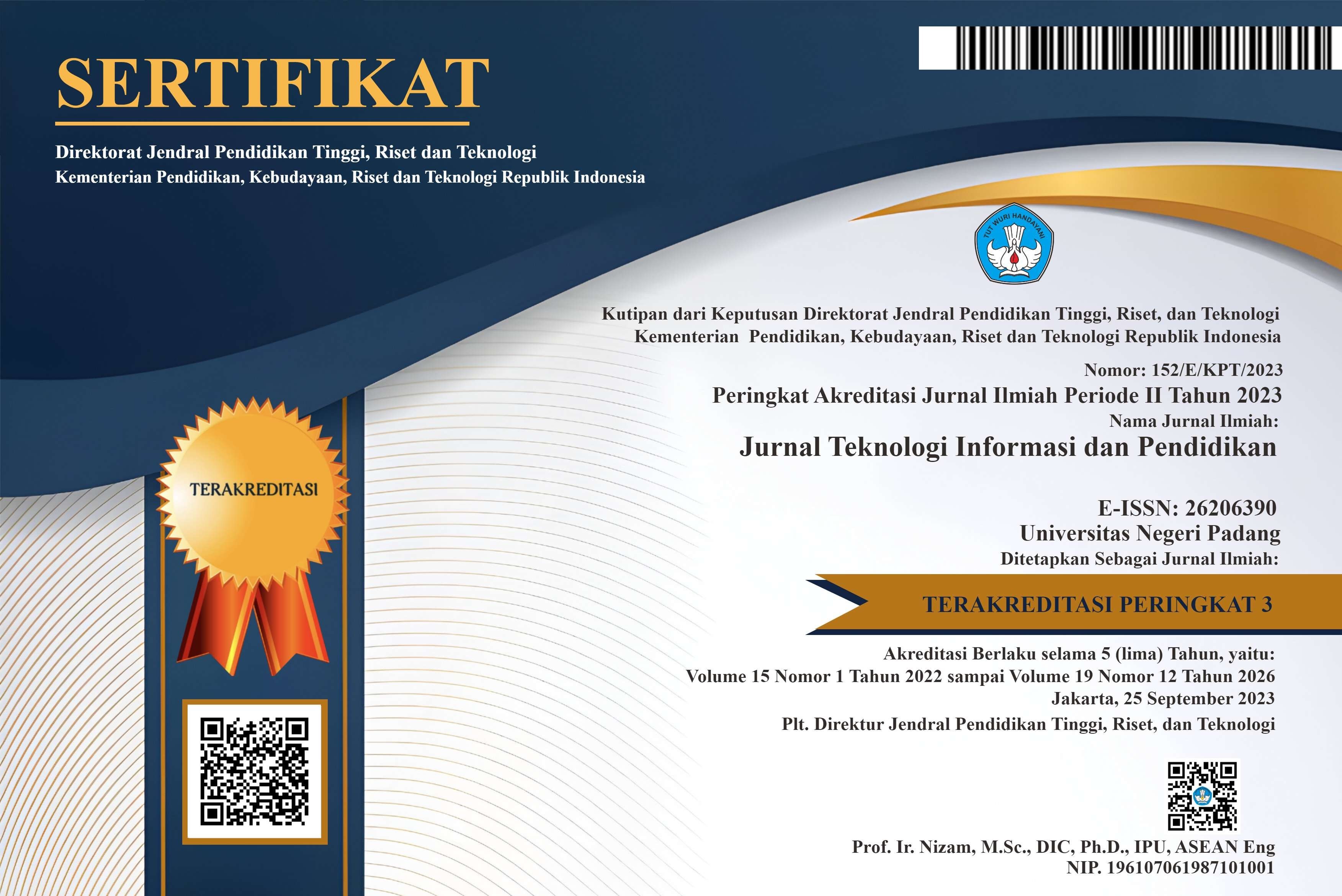ANALISIS KEBUTUHAN: PEMBELAJARAN BERBASIS WEB PADA MAHASISWA VOKASIONAL
Abstract
Entering the digital era, communication and information technology continues to experience development. Therefore the development of these technologies must be adopted and utilized for educational purposes. The availability of teaching materials in the sample environment under study is still very limited, existing learning resources are still general in nature and still contain concepts with conventional formats. The purpose of this study was to determine the need for website-based learning for vocational students. The research sample was taken using Purposive Sampling as many as five Chemical Engineering students. Data collection is done by semi-structured interview methods, unstructured observation and field documentation to determine the urgency of the need for web-based teaching materials. The research instrument was the researcher herself with the help of interview guides. The collected data is then analyzed using Miles and Huberman's analysis theory, then triangulated to find out its validity. Based on the triangulation results from the three data, students are very interested in web-based learning. This research is expected to provide recommendations to policy makers to be able to meet the needs of web-based teaching materials for vocational students to improve their learning outcomes.
References
O. Marques, “The world wide web,” in SpringerBriefs in Computer Science, 2016.
R. Halstead-Nussloch, C. Dickson, K. Greer, S. Siddiqui, and R. D. Tumuluri, “Recursive online class: Advanced web application class prototypes online educational resources,” in ACMSE 2019 - Proceedings of the 2019 ACM Southeast Conference, 2019.
A. Lerner, T. Kohno, and F. Roesner, “Rewriting History: Changing the archivedweb from the present,” in Proceedings of the ACM Conference on Computer and Communications Security, 2017.
T. Bracamonte, B. Bustos, B. Poblete, and T. Schreck, “Extracting semantic knowledge from web context for multimedia IR: a taxonomy, survey and challenges,” Multimed. Tools Appl., 2018.
A. Sendelbah, V. Vehovar, A. Slavec, and A. Petrovčič, “Investigating respondent multitasking in web surveys using paradata,” Comput. Human Behav., 2016.
S. Mayer, A. Ciortea, A. Ricci, M. I. Robles, M. Kovatsch, and A. Croatti, “Hypermedia to connect them all: Autonomous hypermedia agents and socio-technical interactions,” Internet Technol. Lett., 2018.
M. E. Aksoy, F. Guven, M. E. Sayali, and D. Kitapcıoglu, “The effect of web-based learning in pediatric basic life support (P-BLS) training,” Comput. Human Behav., 2019.
A. El-Ali, F. Kamal, C. L. Cabral, and J. H. Squires, “Comparison of Traditional and Web-Based Medical Student Teaching by Radiology Residents,” J. Am. Coll. Radiol., 2019.
M. Hernandez-de-Menendez and R. Morales-Menendez, “Technological innovations and practices in engineering education: a review,” Int. J. Interact. Des. Manuf., 2019.
S. Ginosar, A. Bar, G. Kohavi, C. Chan, A. Owens, and J. Malik, “Learning Individual Styles of Conversational Gesture,” 2020.
Rusman, “Model-model Pembelajaran Mengembangkan Profesionalisme Guru,” in Jakarta: Rajawali Pers, 2012.
W. A. R. W. M. Isa, A. I. H. Suhaimi, N. Noordin, and N. A. Othman, “3D virtual learning environment,” Int. J. Eng. Adv. Technol., 2019.
H. Taneja, “Mapping an audience-centric World Wide Web: A departure from hyperlink analysis,” New Media Soc., 2017.
J. Chen, J. Xu, T. Tang, and R. Chen, “WebIntera-classroom: an interaction-aware virtual learning environment for augmenting learning interactions,” Interact. Learn. Environ., 2017.
A. L. Harris and A. Rea, “Web 2 . 0 and Virtual World Technologies : A Growing Impact on IS Education,” J. Inf. Syst., 2009.
M. Q. Patton, “Enhancing the qualitative and credibility of qualitative studies,” in Qualitative research & evaluation methods, 2015.
N. M. Deterding and M. C. Waters, “Flexible Coding of In-depth Interviews,” Sociol. Methods Res., 2018.
L. S. Borgmann, J. Waldhauer, M. Bug, T. Lampert, and C. Santos-Hövener, “Improving access to migrant populations for epidemiological research—guided interviews with German experts,” Bundesgesundheitsblatt - Gesundheitsforsch. - Gesundheitsschutz, 2019.
A. Fontana and A. H. Prokos, “Unstructured Interviewing, Type of Unstructured Interviewing, Ethical Considerations,” in The Interview, from Formal to Postmodern, 2016, pp. 39–48, 49–67, 77–81.
I. N. K. Wardana, “Teknik Antarmuka Secara Serial Peripheral Interface ( Spi ) Menggunakan Platform Arduino Dan Matlab,” J. Matrix, 2016.
B. S. Brennen, “Ethnography and Participant Observation,” in Qualitative Research Methods for Media Studies, 2018.
A. Galletta and W. E. Cross, Mastering the Semi-Structured Interview and Beyond. 2016.
V. Schoeb and A. Hiller, “The impact of documentation on communication during patient-physiotherapist interactions: A qualitative observational study,” Physiother. Theory Pract., 2018.
L. J. Wu Suen, H. M. Huang, and H. H. Lee, “A comparison of convenience sampling and purposive sampling,” J. Nurs., 2014.
R. A. Krueger and M. A. Casey, “Focus Group Interviewing,” in Handbook of Practical Program Evaluation: Fourth Edition, 2015.
A. Huberman and M. Miles, The Qualitative Researcher’s Companion. 2012.
N. Carter, D. Bryant-Lukosius, A. DiCenso, J. Blythe, and A. J. Neville, “The Use of Triangulation in Qualitative Research,” Oncol. Nurs. Forum, 2014.
P. Fusch, G. Fusch, and L. Ness, “Denzin’s Paradigm Shift: Revisiting Triangulation in Qualitative Research,” J. Soc. Chang., 2018.
A. Pennisi and A. Falzone, “Presentation,” in Perspectives in Pragmatics, Philosophy and Psychology, 2020.
J. Parong and R. E. Mayer, “Learning science in immersive virtual reality,” J. Educ. Psychol., 2018.
K. Mccutcheon, M. Lohan, M. Traynor, and D. Martin, “A systematic review evaluating the impact of online or blended learning vs. face-to-face learning of clinical skills in undergraduate nurse education,” J. Adv. Nurs., 2015.
D. Jie, “Simulation software applied in electronic technology teaching,” in Proceedings of the 2012 International Conference on Industrial Control and Electronics Engineering, ICICEE 2012, 2012, pp. 925–927.
M. Kunter, U. Klusmann, J. Baumert, D. Richter, T. Voss, and A. Hachfeld, “Professional competence of teachers: Effects on instructional quality and student development,” J. Educ. Psychol., 2013.
D. An and M. Carr, “Learning styles theory fails to explain learning and achievement: Recommendations for alternative approaches,” Personality and Individual Differences. 2017.
Copyright (c) 2020 Jurnal Teknologi Informasi dan Pendidikan

This work is licensed under a Creative Commons Attribution-ShareAlike 4.0 International License.















.png)














